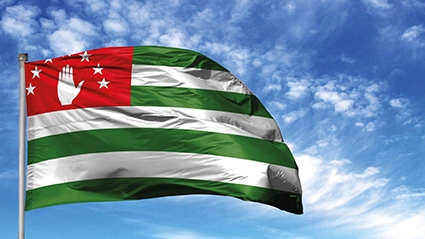Khajimba Wins, Opposition Protest
Op-Ed
Analogies between the presidential elections held in occupied Abkhazia and last year in the rest of Georgia continue. Like the Georgian Dream case, the occupied regime was able to mobilize an unprecedented number of voters during the second round of the elections. Like a year ago, the candidate who came in third in the first round called on his supporters to vote for the opposition candidate in the second round. The election campaign strategy was also similar – pressuring voters, bribes and fraud. The analogies end there, but the second round of elections in the breakaway region had other interesting features too. Let’s take a look.
Raul Khajimba’s forecasts proved true. He said after the first round: “We know where we have worked and where we still have room to gain votes.” And together with his election team, he was able to get the votes he had hoped for. The second round showed that votes had been ‘seized’ from that very electorate which the oppositional candidate thought guaranteed his victory. Sokhumi, the biggest election region of the occupied territory was where Khajimba lost the first round. It seems Putin’s favorite did his homework in Sokhumi and was able to take advantage of the fact, though Khajimba is not a member of the so called Abkhazian elite, which made his situation even more difficult. Khajimba comes from Tkvarcheli, region with the least number of voters. He couldn’t have relied on votes from the region, nor from those of Gali, the region where Khajimba’s policy deprived the majority of their right to vote. Of course, it was clear who the Georgians would vote for, given a chance. Polling stations were open in Moscow and Circassia, where he lost again in the second round, and this fact further reinforces the opinion that Khajimba won over his competitor’s votes, the ones that the opposition had hoped for.
Alkhas Kvitsinia seemed to have a guaranteed victory in the second round: he was supported by the party of former President Alexander Ankvab, which meant that he was supported by the Abkhazian elite and, most importantly, the so-called citadel of Abkhazian independence – the Gudauta region. Alexander Ankvab and the oppositional spectrum decided to support Kvitsinia only a few days prior to the second election. At first, it was thought that the opposition wouldn’t support any candidates, thus leading to the likelihood of a third round. The majority of the opposition supported this scenario, however, everything in the end was decided by the position of Ankvab, the former leader of the occupied regimen. Kvitsinia’s campaign team agreed to get the votes in return for appointing Ankvab as Prime Minister. This is how Khajimba and Kvitsinia came to September 8, but despite such support, Kvitsinia was unable to defeat Khajimba. And while he has already appealed the election results, it is highly unlikely that anyone will annul the final results, results which put Putin’s favorite candidate in power.
Kvitsinia and the whole opposition of Abkhazia believes that the election law was violated, which states that the elections are won by the candidate who gets more votes than the sum of the defeated candidate’s votes and the votes given “against every candidate.” Despite this, there is another article in the law, which states that the winner of the second round is the one who simply gets the majority of votes. Khajimba got 999 more votes, while 3154 people voted “against every candidate.” Perhaps this fact will be the major trump card for the opposition. The results of the elections held in the occupied territory are as follows: Khajimba – 47.38%, Kvitsinia 46.19%, voter turnout 65.98% and the total number of voters 126,950 people.
Whether the legislative collision in the occupied territory becomes the cause of a future political crisis is yet unknown. A crisis like that of 2004, when the Kremlin agreed to having their favorite candidate only as a vice president, but what is noteworthy is that in 2004 too, the Kremlin’s favorite was that same Raul Khajimba.
By Zaza Jgarkava
Image source: emerging-europe.com












